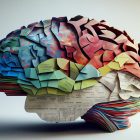
Dream Logic
Understanding the Brain and Mind through Dreams
Have you ever found yourself walking with the moon following you like a helium balloon on a string, seeing yourself from an outside perspective yet knowing it’s truly you? As you traverse a large blue ball beneath a star-filled sky unlike any you’ve ever seen, you feel a profound sense of peace. Suddenly, the serene scene dissolves as an incessant sound pulls you back to reality, and you instinctively reach to silence your alarm. The room comes into focus, leaving you puzzled by the strange world you were just visiting.
The logic within dreams has always fascinated me. From a young age, we realize that dreams often defy the laws of physics and social norms of daily life. The most fantastic events and unlikely scenes play out in our dreams, governed by a unique structure of logic.
The online Urban Dictionary defines “dream logic” as: “1. The nonsensical logic one possesses while dreaming that makes perfect sense until he or she wakes up, and 2. Information one magically/automatically possesses in a dream without having learned it before.” This term has found its place in film studies, where movies exploit the unusual logic of dreams to create emotional experiences. This works because we intuitively understand how events in dreams differ from those in waking life.
The concept of dream logic has become popular, appearing in various media. It’s the name of a Marvel comic book series, a computer software development company, a sleep aid supplement, and an episode of the science fiction TV series Fringe. A collective of artists and technologists even adopted the name to create immersive art experiences, such as the 747 project at Burning Man in 2017.
Movies and TV programs with significant dream logic elements are listed on the Internet Movie Database. Director David Lynch’s works, particularly Mulholland Drive and Twin Peaks, are noted for their dream logic. These challenging pieces push us to think non-linearly and emotionally rather than rationally. In an interview, Lynch explained his affinity for dream logic, stating, “Not much, except daydreaming. Very rarely have I gotten ideas from nighttime dreams, but I love dream logic. And cinema can [show] dream logic.” His works resist straightforward explanation, allowing each viewer to derive personal meaning.
David Gelernter, a computer scientist at Yale University, argues that understanding human thought requires acknowledging both ordinary logic and dream logic. As he states:
“We need to see, first, that in approaching the topic of human thought, we usually stop half-way through. In fact, the human mind moves back and forth along a spectrum defined by ordinary logic at one end and ‘dream logic’ at the other. ‘Dream logic’ makes just as much sense as ordinary ‘day logic’; it simply follows different rules. But most philosophers and cognitive scientists see only day logic and ignore dream logic—which is like imagining the earth with a north pole but no south pole.”
(David Gelernter, 9/13/2020, Dream-logic, the Internet and artificial thought, The Edge)
Dream logic arises from the brain processes active during REM sleep. As we transition into REM sleep, areas of the brain dominant during wakefulness become less active while other areas become more active. Without external information, the images we experience are generated internally, interpreted independently from reality. The limbic system, responsible for processing emotional material, becomes especially active, leading to powerful emotional experiences. During REM sleep, higher cortical areas involved in logical reasoning are less active, possibly due to the release of acetylcholine (Muzur, Pace-Schott, & Hobson, 2002).
Psychologically, dreams may not be random images we try to make sense of but rather represent the use of imagination during sleep. The book Fan Phenomena: Twin Peaks suggests that “Dream logic embraces embodied instinct and cosmic self-awareness, our lowest animal desires and our highest spiritual aspirations, our darkest fears and our brightest joys. It governs a much wider range of experiences and realities than is normally recognized by waking consciousness.” This freedom, while unsettling, can be a source of creativity, essential for understanding human experience as Gelernter suggests.
Examining the strangeness of our logical processes during sleep helps us understand how the brain works during dreaming. Certain directors use this unusual logic to create art that challenges us, drawing us into experiences that differ from ordinary reality. To fully grasp human experience, understanding dream logic is crucial, and cinema might help us achieve this.
If you want to explore your own dream logic, consider keeping a dream journal. Upon waking, write down any lingering traces of dreams. Over time, your recall will improve, allowing you to analyze your dreams’ themes and emotional states. This practice might enhance your daytime creativity and provide insights into your personal dream logic. Give it a try—sleep on it, then start journaling.
This article was produced by Dream Deus AI under editorial supervision.
Original article: https://www.psychologytoday.com/intl/blog/sleepless-in-america/202009/dream-logic




